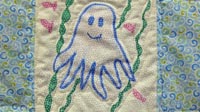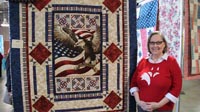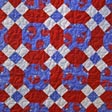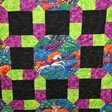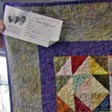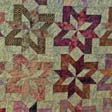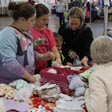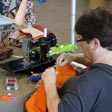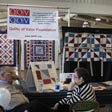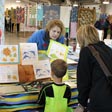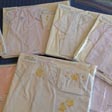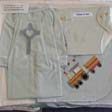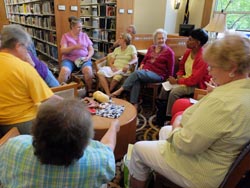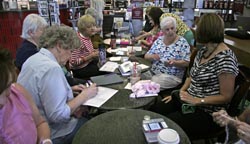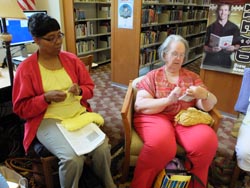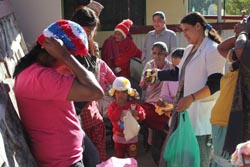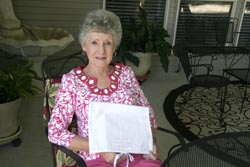Stitching Community: Fiber Arts and Service
By Laura Marcus Green

Introduction
What is it about a quilt in times of trouble? How do a knitted shawl or a crocheted hat ease life passages like illness, recovery from trauma, survival of natural disasters, or loss of a loved one? How do handmade items manifest prayer or spirituality? Further, how does the making of these items provide joy, comfort, connection, and even meditation for their makers? How do these art forms bring people together, often forging friendships and community among those who would otherwise be strangers? Over a ten-day fieldwork survey of fiber arts and community service in East Baton Rouge Parish, these questions were posed to artists of diverse traditions—sewing, knitting, quilting, crochet, embroidery—about the work they do to support and comfort others in their community and beyond, through the work of their hands. There is just something about handwork and service, no matter where you go, no matter what the situation. As quilter Bonnie Moates put it, "Anywhere you look, there's a need for quilts."
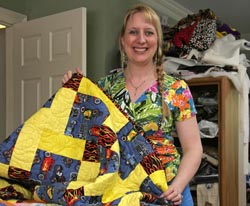
Examples of handworkers' generosity and concern about diverse civic and global issues abound. For generations, traditional fiber artists have lent their talents to raising awareness and funds for various causes. These artistic expressions, practiced in diverse cultural communities, are rooted in traditions that have been handed down from one generation to the next. When applied towards community service and relief projects, they bring beauty and comfort to others, and most often serve a practical purpose. They also strengthen the fabric of our communities, bringing humanity and care to a host of issues.
It turns out that Baton Rouge is especially rich in fiber artists and organizations who share their time and talents to support those who are dealing with challenging issues—people recovering from natural disasters, cancer and Alzheimer's patients, domestic violence survivors, children transitioning into foster care, children of incarcerated parents, families of stillborn or miscarried babies or those with a baby in neo-natal care, women recovering from human trafficking, and homeless community members, among others. Most often, handworkers never meet the recipients of their donated creations. How is it that they put so much care and time, not to mention volumes of yarn, fabric and thread, into helping others they most often do not even know? Quilter Mary Woltman has been involved with quilting groups in three states. She observes, "Quilters—the thing I've encountered, they're all caring, generous people, in terms of wanting to do something."
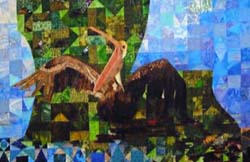
A quick internet search reveals hundreds of fiber arts and service projects, complete with patterns, testimonials, and invitations to get involved. Just enter an art form and a cause or issue, and you will be connected. Some of the handwork and community service projects in Baton Rouge are local chapters of national projects, such as Quilts of Valor, whose mission is to is: to cover service members and veterans touched by war (www.qovf.org), or Home of the Brave, another military-themed quilt initiative which provides quilts to families of fallen heroes (www.homeofthebravequilts.com).
National projects like Project Linus (www.projectlinus.org), Quilts for Kids (www.quiltsforkids.org), and ConKerr Cancer (www.conkerrcancer.org) provide comfort to children facing treatment for life-threatening illnesses or facing other traumatic situations in the form of quilts, blankets, and colorful pillowcases. The Prayer Shawl Ministry covers a broader range of life passages, from illness and loss to more celebratory moments such as marriage or graduation (www.shawlministry.com). Most of these organizations began with a particular story or localized need, eventually expanding into national initiatives whose magnitude is matched by their relevance across the country.
Baton Rouge is also the birthplace of some remarkable projects that have grown to regional, national, and even international proportions. The Giving Quilt began in 2008 with a show put on by the Stashbuilders Quilt Guild of Gonzales, featuring 35 quilts made for the national Quilts of Valor project. Over the ensuing years, the project grew and broadened its focus. The Giving Quilt ultimately became an established 501(c)(3) organization that holds a biennial show. This event features well over 600 quilts (at last count!) that are donated to over 40 local, regional, national, and international charitable organizations, from youth programs to health care providers and natural disaster relief, among many others. Contributions to the show come largely from local quilters and quilt guilds, but also include donations from regional and national sources (www.thegivingquiltinc.org).
The Giving Quilt has an auxiliary arm, the Wasted Women's Bee. The Wasted Women, as they are known, take their name from the fabric scraps or "waste" that go into quilts that are donated to a host of civic and charitable causes. Wasted Women members meet bi-weekly to organize and distribute mind-boggling quantities of donated fabric and quilt kits that they prepare from their stash. Quilters from around the area transform these materials into quilts that become part of The Giving Quilt's reserves. Between its biennial shows, The Giving Quilt stores up quilts to have at the ready for special needs or situations that arise. While giving and quilts are practically synonymous nationwide, nowhere has the creation and distribution of community service quilts attained this level of organization, volume and, potentially, artistry. The Giving Quilt and Wasted Women are truly unique phenomena. 1
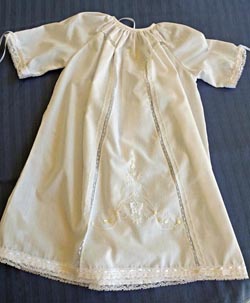
Another likewise extraordinary organization with Baton Rouge roots is Threads of Love, which began as a church ministry to provide clothing and blankets for premature, stillborn, and miscarried babies and their families. In 1993, founder Sissy Davis responded to a call that came one day at her church from a local doctor seeking items to clothe these babies and comfort their families. Today, the organization has grown to over a hundred chapters throughout the United States, with some international members (www.threadsoflove.org). Over the years, Sissy has formalized the process for establishing a Threads of Love chapter, providing instructional manuals for chapter leaders and members. The organization holds a biennial conference that brings together chapter members from around the country to learn, share, and provide mutual support. Threads of Love's operations encompass a network of related professional fields, as Sissy has forged relationships with neo-natal doctors and nurses, coroners, and funeral directors, ever honing her project to work effectively with these kindred service providers.
Notes
1. Katherine Bell's edited volume, Quilting for Peace: Making the World a Better Place One Stitch at a Time (2009), presents community service quilt stories illustrating some of the ways in which quilters have addressed diverse social issues. In their 2012 article, "Quilts & Health," Marsha MacDowell and Clare Luz explore the interface between quilts and health as a nexus of self-expression, healing, and advocacy, highlighting the stories that give meaning to these special textiles.
Common Threads
What follows are the stories of these and other Baton Rouge fiber arts and community service projects, and of some of the individuals who create handmade items for others as a labor of love and an act of service. This essay is based on folklife field research conducted in May 2014, encompassing interviews with diverse handworkers, attendance at various fiber arts gatherings, and documentation of a sampling of arts groups and organizations in the East Baton Rouge Parish area. This is but a snapshot of Baton Rouge's fiber arts and service landscape. The breadth and depth of this phenomenon is vast-far greater than the scope of a ten-day visit would allow. Nonetheless, these stories are a window onto the incredible artistry and dedication revealed by the research, even in a short time. Amidst the diversity of art forms, individuals, affiliations and projects, there were some striking parallels and themes among the handworkers and the initiatives documented for this project.
The Benefits of Belonging
Most guilds have a multifunctional mission. They're about education, about fellowship, and about charity.
—Mary Woltman
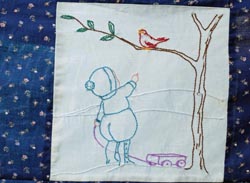
One has only to pull out a handwork project and begin stitching in an airport, waiting room, or other public setting to notice that fiber arts have a magnetic quality. "What are you making?" has begun many a conversation among strangers, as people connect to an art form practiced by a family member, or fellow fiber artists admire each other's work and even exchange patterns or techniques. Beyond these chance encounters, handworkers find one another in any number of ways. Some of the groups documented for this project took root serendipitously, beginning as a small knitting or crocheting class and blossoming into a weekly gathering with ten, twenty, thirty or more members. This was the case for Crafting for a Cause, predominantly but not exclusively a crochet group that meets at the Pride-Chaneyville Branch of the East Baton Rouge Public Library. The Knit Wits Christian Ladies Knitting Group, who gather at a CC's Coffee House one morning a week, has a similar history.
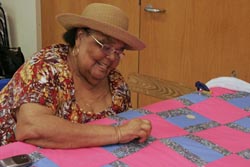
Some fiber arts groups are longstanding institutions, providing an anchor of stability in changing communities. The old-time hand-quilting bee has deep roots in American culture and may be a prototype for today's multifaceted fiber arts groups. The Chaneyville Community Center hand quilters' group is at least three generations deep. Mabel Burks, along with her sisters Dorothy Spain and Sarah Bilies, regularly attend the quilting bee. From her childhood in the Chaneyville area, Mabel remembers when neighbors gathered around her mother's quilting frame to stitch together and visit. Mabel's niece, Geraldine Anderson, recently retired, represents a new generation to join the circle. Today, the Chaneyville quilters come to the Community Center several days a week, continuing the tradition of hand quilting and socializing but in a public setting. Many in this group have at one time or another moved to other parts of the state and country for work, some spending years or decades away from Chaneyville. The quilting circle reconnects them with their home community, providing camaraderie, entertainment in a rural setting, and the opportunity to make an abundance of beautiful quilts.
More formalized quilting, weaving, and embroidery guilds take shape in perhaps a more deliberate way, but are likewise established out of a mutual desire to learn and practice a particular art form. Such groups also represent a longtime tradition across the United States and beyond. Baton Rouge is home to a number of fiber arts guilds. The old-time bee, where quilters sit around a frame to hand-quilt, has largely been replaced by quilting guilds. Generally, quilting guilds meet monthly and hold structured meetings where members conduct business, share news and finished projects, and often have a lesson. Little actual sewing or quilting takes place at these gatherings. Among quilt guilds, actual hands-on stitching is the domain of quilting retreats or sew-ins, sometimes for particular projects. At these gatherings, quilters tend to work on their individual projects at portable sewing machines, rather than stitch collectively on one quilt. Some fiber artists belong to multiple groups, as their time and interests allow.
Fiber arts circles of all stripes offer members opportunities to hone their skills and learn new techniques. More formalized guilds offer lessons and workshops through which members can expand their repertoire. Many quilt guilds host "challenges," in which those who participate try their hand at working with a particular pattern, technique, theme, fabric, or color. Sometimes these challenges entail rotating kits or materials among members, so that each quilter ends up with a piece on which others have worked. The process and results of these challenges offer a fascinating study in individual creativity, as each member puts her own spin on the same basic project.
More informal fiber arts circles likewise provide a place to grow. Crafting for a Cause and Knit Wits members unanimously report that knowledge and help are freely shared among their members. Staff and volunteers at the Chaneyville Community Center often provide instruction and inspiration for trying new patterns. Likewise, those who show up to Threads of Love's monthly sewing meetings share newly acquired techniques with one another. These group settings furnish a synergy and diversity in talents, fertile ground for expanding and deepening one's technical skills and creative horizons.
Although a mutual interest in fiber arts may be the initial draw, many report other significant benefits to belonging to fiber arts circles. "It's about more than crocheting," Crafting for a Cause founder and leader Linden Langberg observes. Far-reaching changes in handwork traditions and fiber arts circles mirror transformations in our society over time, including the prevalence of women working outside the home and the increased availability of fabric, patterns, and time-saving tools and technology. Yet, a continuous thread from the hand-quilting bee to today's quilt guilds and other fiber arts circles is the importance of camaraderie among members. A quilter in rural Colorado once told the author, "It used to be that we were isolated by our farms. Now, we are isolated by our cubicles. We still need each other. We still need to come together!"
Regardless of their size or focus, fiber arts groups bring together individuals who might not have met otherwise, yet who often forge strong friendships, even a sense of family. Many fiber arts groups hold social events and go on outings outside the context of regular meetings. The Knit Wits gather twice a year at members' homes for a jambalaya meal in the summer and a Christmas potluck in the winter. Field trips to regional yarn stores also figure into their regular activities, along with going to lunch following their weekly stitching circle.
In our mobile society, fiber arts circles are a way of finding community when people uproot and move to a new place. Many fiber arts groups have websites or Facebook pages, making them easy to find. Public libraries, yarn or fabric stores, and cafes or coffee shops are likely places to seek out fiber arts circles. Knit Wits member Tanya Sevin often accompanies her husband as he drives a truck around the country for refinery shutdowns. A prolific and talented stitcher, she seeks out knitting groups wherever the road takes her, often knitting in the truck as they travel. Quilters Renée Hoeprich and Mary Woltman have relocated to Baton Rouge from other parts of the country. Having belonged to guilds in their previous homes, they sought out the quilting community in Baton Rouge. Renée reflects on her appreciation for the kinship she feels with other quilters. For her, there is much joy in "finding other people who do what you do, who sort of understand that we take perfectly good fabric, cut it into little pieces, and sew it back together."
Linden Langberg reflects about Crafting for a Cause, "It's kind of funny that it went from, 'Can you teach me how to crochet?' to up to fifteen ladies who cook, and we love to eat and we love to go out to lunch together, and we read all the same books. And we even have a short moment there where people will say, so-and-so's having surgery, please keep them in mind this week. . . . Sort of in the middle [of the meeting], closer to the end, everybody, people will start saying, 'I'm going to go have my cataracts done next week, so I won't be here, so y'all think about me . . . . you know. And they've really gelled into a very tight group, who's always calling each other, always checking on each other. If somebody doesn't show, we'll go, 'Okay, where is she?' And somebody'll say, 'Oh I talked to her yesterday, she had to take her husband to the doctor today.' They're all in contact with each other now, on an almost daily basis."
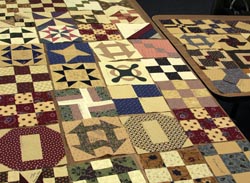
Perhaps because of the sense of family that develops among many of these groups, members tend to take care of their own in times of need. Most quilt guild agendas hold a time slot for reporting on people's personal lives, when news of birthdays, illnesses, or deaths among members and their families is shared and cards are circulated for all to sign. Given the context, it is not unusual for handwork circle members to collectively create a quilt or other item as a show of solidarity and caring for one of their own. At a monthly Remember Me Quilt Guild meeting, Mary Woltman received a surprise birthday gift-a box of quilt blocks made in her favorite fabrics by other guild members.
What Goes Around Comes Around: A Grassroots Economy of Materials and Caring
I think that's what makes a quilter a quilter, is that we want to use those little hunks of fabric, instead of throwing them away.
—Connie Ewbank
Perhaps the prevalence of generosity and civic concern among handworkers originates in the place fiber arts often hold in people's lives. Considered "domestic arts" in some circles, fiber arts have long been a means to provide for one's family, a nurturing and necessary practice woven into the fabric of our lives. The creation of handmade items for those beyond one's immediate family or network extends that nurturing further out into the artists' community and beyond.
These acts of generosity have a practical dimension, beyond their rootedness in civic engagement. Denham Springs quilter Connie Ewbank observes, "I think one of the reasons people like to do charity quilts though, too, is that after they've made quilts for everybody in their family, they still want to keep making quilts. But what are they going to do with them? So they make quilts for people that they can give to." Quilter Renée Hoeprich explains her love of quilting and sharing it with others: "It's a big part of my life, and you can only make so many quilts for yourself and the people around you, that I and lot of people here have expanded into making quilts for others."
Service projects offer a sense of purpose. Linden Langberg of Crafting for a Cause explained how the group began directing their efforts towards service projects:
We wanted to continue to make things and learn and develop our skills. But we'd given all the hats we could to family members. And we didn't really feel that our skills were quite up to par to be able to actually sell them, and what were we going to do? We didn't want to turn into a business. Because we're city government, I'm a city government employee. So I couldn't become a business, and we needed to somehow—we wanted to feel that we weren't just sitting around crocheting, for nothing. And so, our only thought was, let's find someone who can use this and give it away to them.
Many fiber artists are known to have large accumulations—some say rooms full—of fabric, yarn, notions, and finished projects. Having a dedicated project allows fiber artists to indulge their passion for—some say addiction to!—their art forms, while creating something of use to others and filling a need in the community.
There is an interesting economy among community service fiber arts projects. Many service projects, whether quilted, crocheted, or knitted, are made from donated materials. The Wasted Women exemplify this phenomenon writ large by warehousing massive amounts of fabric that is then farmed out to quilters and guilds, exclusively for service projects. As they become known in the community for their service projects, fiber arts groups become a repository for donated yarn and other materials, as friends and family thin their own stashes, or find a new home for the cache of a loved one who has passed away. Linden Langberg observes about the materials that are donated to Crafting for a Cause, "The yarn just comes in. It's crazy, I'll show up one day and there'll be a big pile of yarn. And the word has gone out and everybody knows, if you have yarn, if Aunt So-and-So died and she's got a house full of yarn, you just pack it up and send it to Pride [Pride-Chaneyville Library Branch], because they're going to take care of it and they're going to make great things out of it."
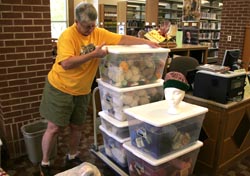
The Knit Wits likewise receive donations of yarn. Brenda Averette of the Knits Wits relates that they have a donor whom they "fondly call 'charity yarn.' Sometimes it is so much, we put it in the trunk of our car and take it to knitting. While there, we open the trunk and all go out and take whatever they like. So we call that 'trunk yarn.'" Crafting for a Cause members enjoy the benefit of a library storeroom where they keep large plastic bins of yarn and finished projects awaiting donation or sale at their fundraiser. Donating materials for service projects is a way for community members who may not have the time or skills to create items for others to contribute to a meaningful cause. The fiber arts circles receiving these gifts pay it forward, generating items that go back out into the community. Generosity squared.
Many fiber art forms have traditionally relied upon ingenuity and thrift for their raw materials, as in the case of quilts made from recycled clothing, flour sacks, and old blankets, or rag rugs that incorporate repurposed fabric or yarn, often too far gone to be of use for anything else. Some dexterous fiber artists unravel worn garments or other textiles to salvage usable yarn for another project. Even as our society seeks new ways to "go green" and conserve resources, handwork has long been the province of this type of repurposing. Contemporary fiber artists perpetuate this ethic of thrift and recycling in the ways that some community service items are made and distributed. Baton Rouge's many fiber arts and community service projects provide an outlet for leftover or unused fabrics and yarn. Connie Ewbank observes, "What is it, 'Use it up, or do without?' But if you throw it out, it's just waste. And I think that's what makes a quilter a quilter, is that we want to use those little hunks of fabric, instead of throwing them away. Where maybe a more modern housekeeper would make something and throw the rest of it away."
Fiber arts guilds and circles provide a means through which members can find a new home for their cast-off materials. The River City Quilt Guild holds an annual silent auction for which a dedicated committee receives and organizes all manner of fabrics, thread, notions, books, patterns, and tools into baskets that are donated and then purchased by Guild members. Eighty percent of the proceeds go to Parker House, a local home for children who are in foster care, having been removed from their homes because of abuse or neglectful situations. Through their donation the guild hopes to make life as normal as possible for the children. The remaining 20% of auction proceeds go towards the guild's education fund, which supports bringing instructors for special classes and subsidizing the cost of these classes for members. At their annual Christmas luncheon, the Knit Wits hold a yarn swap where one member's scraps are another's treasure.
Even in this economy of donations and recycling, many fiber artists also spend their own money to buy materials for service projects. In these instances, the purchase of raw materials constitutes part of the gift, along with the actual handwork. In some cases, fiber arts groups collectively raise funds for materials to use in their service projects. Crafting for a Cause participates in the Pride-Chaneyville Public Library's Community History Festival, where they sell finished products like pot-holders, cell phone cases, and other items. The proceeds from these sales go towards supplementing their stash of donated materials with specialty yarns needed for making wool hats for leprosy patients in Nepal, for example, or especially soft caps for chemotherapy patients who lose their hair. The circulation of donated and repurposed materials and the items made from them reflects a fascinating grassroots economy.
Finding Common Cause & Giving to the Community
Fiber arts have long been a means of advocacy through which women have addressed issues that are important to them. Fiber arts and service projects connect people to local causes and situations in their community, including cancer treatment, neonatal care, neglected or abused children, human trafficking, teen pregnancy, and veterans' affairs, among others. Among Baton Rouge area fiber artists, children seem to receive special attention—whether they are dealing with serious health issues, neglect or danger, poverty or other situations. Perhaps the fiber arts are seen as a way to nurture more vulnerable community members. Handmade items are also donated to victims of floods, tornados, and hurricanes. Such circumstances hit close to home for Baton Rouge and Louisiana residents, who have endured more than their fair share of natural and man-made disasters in recent years.2
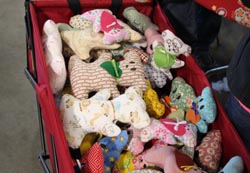
There is a sense that fiber arts donations fulfill an urgent need in times of crisis. Many of the projects documented for this project supply hospitals, fire and police departments, and various shelters with stockpiles of handmade items to be available when the need arises. It was striking how many interviewees described recipients of their donated handwork as having to leave home with nothing but the clothes on their backs-whether fleeing a flood, tornado, fire, domestic violence, human trafficking, or a neglectful home. The service organizations providing care for these individuals keep handmade quilts and afghans, clothing, teddy bears, and other items at the ready to provide comfort to those facing trauma. The handworkers' appealing yet practical gifts may be among the recipients' only possessions at a time when they are in transition or rebuilding their lives.
Service projects offer handworkers a way to care for others in need. Sometimes handworkers engage directly with recipients of their work. Most often, however, they don't know the people for whom they are making donated items, even if they live in the same community. There is a "kindness of strangers" element to fiber arts and community service projects. An exception is the St. John's United Methodist Church Prayer Shawl Ministry, whose creations are often more personalized expressions of caring. Generally, the shawls go to a particular, known individual in need. In fact, most prayer shawls are custom made, with colors and designs reflecting the recipient's particular situation. Pink shawls are knitted or crocheted for breast cancer patients, for example. Prayer shawls are often accompanied by a hands-on ritual at the time the shawl is given. The St. John's United Methodist Church Prayer Shawl Ministry also keeps some prayer shawls on hand, to have available as the need arises.
Even when they don't know the recipients of their donations, handworkers engaging in service projects often have a personal connection to a particular cause, be it through a relative in treatment for cancer, for example, or a family member who works in child protective or other social services, or a son or daughter in the military, among many other possible scenarios. These connections foster awareness and concern among fellow fiber artists, often determining the recipients of donations from a fiber arts circle. Regardless of a direct personal connection, engaging in fiber arts and service projects brings handworkers closer to community causes or life events, putting a more personal face on the issue at hand. Work on such projects potentially cultivates empathy for others.
Among some fiber artists interviewed for this project, there was a sense that, "this could have been me." Illness, death, natural disasters and a host of other life events can and do happen to any of us. Sometimes it seems as if participation in community service projects creates a buffer. In other words, you can make a difference without having to get too close to situations that are painful to consider or experience directly. One stitcher sitting around the Knit Wits circle commented, "I'd much rather be at the giving end than the receiving end of these gifts." Perhaps making and donating these items gives people a sense of agency and protection, almost as if they had a choice about the life events that befall them.
Coming together around a common cause through shared art forms can help fiber artists deal with life passages—their own or others'. Many fiber artists interviewed for this project imagined how much they would appreciate receiving a handmade item during a challenging time of their own. Often, they commented, "I'd like to think that if I were going through this, others would do the same for me." Some spoke from personal experience, having received such gifts during hard times.
Reminiscent of a time when their handwork was one of the only vehicles through which women had a political voice, today's fiber artists still vote with their fingers. Whether they are contributing to the wellbeing of leprosy patients in Nepal or U.S. war veterans, or supporting pro-life organizations or anti-human trafficking efforts, handworkers connect to contemporary issues through their community service projects. Handwork may be considered a quaint domestic hobby in some circles. But through their service projects, fiber artists show that they are very much in synch with the world around them, taking the pulse of their communities and beyond, and responding in kind and kindness.
Judy Holley is a quilter, quilt designer, and quilting instructor who helped found the Wasted Women, and who has taken contributed to many civic quilting projects. She reflects:
I remember I was very frustrated [because] when you tell somebody that you're a quilter, their image of what quilting is, who quilters are, and what they do is kind of . . . I don't know, 19th century, you know? And I thought that quilters didn't have any public visibility in the community. We're more than just your grandmothers, little old ladies sitting around with nothing better to do. Which is what a lot of people think."
Notes
2. Minden in north Louisiana was the site of a large quilt project in response to Hurricane Katrina. See Susan Roach's 2011 article "The Quilting Queens: Responding to Katrina" on the National Quilt Index website. Matrix, Michigan State University and the Quilt Alliance http://www.quiltindex.org/essay.php?kid=3-98-26.
The Disaster Quilting Project showcases the ways quilters have addressed various types of crisis situations through quilting. This web-based project provides a discussion about disaster quilting, a gallery and stories about the quilts. http://disasterquiltingproject.com/
In Their Hands: Making it Better
You can't make a quilt without putting love into it.
—Connie Ewbank
Circling back to our initial question, what is it about fiber arts that make them, in part, a salve for life's challenges? Many who were interviewed for this project replied that handmade items provide comfort and beauty, while letting others know that someone is thinking of them and sending support, even love. Further, fiber arts are generally a practical art form. Recipients not only need comfort, beauty and support, they could also use a hat when they have lost their hair during chemotherapy, or when the weather is cold. The practical and emotional dimensions of fiber arts and service are interwoven. What explains these connections between hand and heart? Here are some of the fiber artists' responses to this question, in their own words.
Quilter Renée Hoeprich is engaged in numerous service projects. She muses:
Well, I think quilting, what we do—I mean, we come up with something very tangible. You know, you have a quilt. It's very different from working in a soup kitchen, shall we say. Well, you are feeding someone. But there's something—you know, there's that aspect where a quilt brings warmth to someone. But it's also a token of, someone took the time to make a quilt for people. I mean, it would take me a whole lot less time if I went to WalMart and bought a stack of blankets and handed them out, but it's not the same.
Threads of Love founder and Director Sissy Davis considers the healing impact of handmade clothing and blankets on parents grappling with premature, miscarried, or stillborn infants. Generally, she does not interact with the recipients of these sets, but she hears from the medical staff who deliver them how meaningful they are. "I think it reflects the love that goes into each garment. We're not just mass-producing. We have a basic pattern that all of our clothes are made off of because they're designed to fit these different sizes, the babies. . . . Each one is made by an individual who is trying to make that [item] as sweet as they can, to make a memory for that mother."
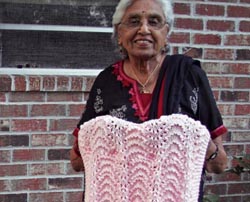
Saroj Welch sometimes knits late into the night in order to finish a project for the St. John's United Methodist Church Prayer Shawl Ministry. As she works, her stitches and prayers intertwine. She reflects, "When I get responses from the people I give the prayer shawl to, I'm really so encouraged to do more because I know that this does serve a purpose. And people feel the presence of God as they wrap themselves around [in the shawl]. And they are comforted, they know that we love them, they know that God cares. This is our way of showing them that God cares. . . . [The shawl] wraps around you . . . just covering you with love. One of the persons, when I gave it, he just pulled it around him, and said, 'I can feel the Spirit.' I mean, when you hear expressions like that, it's worth staying up and doing it."
Quilter Candy Bergeron understands firsthand the feeling of receiving a quilt made just for her. She grew up in a family of women who gathered annually to quilt together and provide quilts for family members. As a founding leader of The Giving Quilt and an active member in the Remember Me, Stashbuilders, and River City Quilt Guilds, as well as the Gulf States Quilting Association, she observes, "Oh, when someone makes a quilt for you? You know that they really love you, because they took the time to do it. Because this isn't a quick process. Even with our new tools and with machines and stuff, it's not a quick process. And so, that they thought about you, they took the time to do it, that means . . . the comfort isn't just from being warm under the quilt, it's [from] being loved."
Crafting for a Cause members stitch items for residents of Hope House, a shelter for those transitioning from human trafficking. These items include washcloths, blankets, and bags for make-up and personal items. These items are given to Hope House residents at various times during their stay. Crafting for a Cause founder and leader Linden Langberg notes, "It's important to them to get these handmade items because a lot of them have spent most of their lives thinking that no-one really cared for them as human beings, and not as something just to get something from, you know. [It's meaningful] that these are gifts given to them, just because they are valuable people. You know? And cared for."
When disaster and misfortune strike even those we don't know, we might feel helpless, wishing there were something we could do to alleviate the suffering of others. Although the situation might be out of their hands, handworkers can contribute through the work of their hands. Quilter Mary Woltman has been a proponent of community service quilts in her leadership roles in both the River City Quilt Guild and the Gulf States Quilting Association, a regional organization. She reflects:
You can't change the circumstances that people are in. You know, you can't undo a tornado, you can't undo a hurricane or a fire. But I think quilters—and this is the ones I've [met], [in] three different states now—your goal is to provide some love and some comfort in that. Because you can't undo what's being done. And I've been very blessed in terms of, I haven't experienced those kinds of hardships. I mean, we've had hurricanes but we've never lost our house or things. But I would hope that the recipient understands, would feel that love, and the care that [goes into a quilt]. And to me, when you think about it, people that you don't know doing something for you. They've never met you, but they just did it to try to help you through a certain time, a crisis. And these are people you'll never meet. And quilts do that. Maybe it's because I'm a quilter that I think that. But I think that's the goal behind it.
Ultimately, the gift comes full circle. If handmade items provide comfort for recipients, fiber artists themselves also benefit from the process of creation and the act of giving to someone in need. Linden Langberg explains the rewards of her work with Crafting for a Cause: "To be able to just give of our time and give of our talents, and give away these things is such a blessing to us, because we have so much. We need to be able to give to others. So it makes us feel better." Knitter Louise Doherty would agree. About her participation in the Knit Wits' circle she says, "I feel like I just had a B-12 shot. That's how great it makes me feel."



